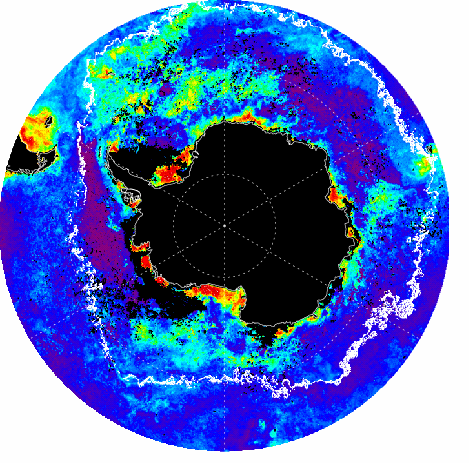 ©2020 Biological and Chemical Oceanography Data Management Office.
©2020 Biological and Chemical Oceanography Data Management Office.Funded by the U.S. National Science Foundation
Collaborative Research: Plankton Community Structure and Iron Distribution in the
Southern Drake Passage and Scotia Sea
The Shackleton Fracture Zone (SFZ) in Drake Passage of the Southern Ocean defines a
boundary between low and high phytoplankton waters. Low chlorophyll water flowing
through the southern Drake Passage emerges as high chlorophyll water to the east,
and recent evidence indicates that the Southern Antarctic Circumpolar Current Front
(SACCF) is steered south of the SFZ onto the Antarctic Peninsula shelf where mixing
between the water types occurs. The mixed water is then advected off-shelf with
elevatediron and phytoplankton biomass.
The SFZ is therefore an ideal natural laboratory to improve the understanding of
plankton community responses to natural iron fertilization, and how these processes
influence export of organic carbon to the ocean interior. The bathymetry of the region
is hypothesized to influence mesoscale circulation and transport of iron, leading to
the observed patterns in phytoplankton biomass.
The position of the Antarctic Circumpolar Current (ACC) is further hypothesized to
influence the magnitude of the flow of ACC water onto the peninsula shelf, mediating
the amount of iron transported into the Scotia Sea. To address these hypotheses, a
research cruise will be conducted near the SFZ and to the east in the southern Scotia
Sea. A mesoscale station grid for vertical profiles, water sampling, and bottle incubation
enrichment experiments will complement rapid surface surveys of chemical, plankton, and
hydrographic properties. Distributions of manganese, aluminum and radium isotopes will
be determined to trace iron sources and estimate mixing rates.
Phytoplankton and bacterial physiological states (including responses to iron enrichment)
and the structure of the plankton communities will be studied. The primary goal is to
better understand how plankton productivity, community structure and export production
in the Southern Ocean are affected by the coupling between bathymetry, mesoscale circulation,
and distributions of limiting nutrients. The proposed work represents an interdisciplinary
approach to address the fundamental physical, chemical and biological processes that
contribute to the abrupt transition in chl-a which occurs near the SFZ. Given recent
indications that the Southern Ocean is warming, it is important to advance the understanding
of conditions that regulate the present ecosystem structure in order to predict the effects
of climate variability. This project will promote training and learning across a broad
spectrum of groups. Funds are included to support postdocs, graduate students, and
undergraduates. In addition, this project will contribute to the development of content
for the Polar Science Station website, which has been a resource since 2001 for instructors
and students in adult education, home schooling, tribal schools, corrections education,
family literacy programs, and the general public.
Naturally occurring radium isotopes (224Ra, 226Ra, 228Ra) were used in determining
lateral mixing processes which are reported in dpm/m3.
Particulate organic Carbon (POC) flux was determined through measuring Thorium (234Th) reported in dpm/kg.
Cruises
AMLR (Antarctic Marine Living Resources) R/V Yuzhmorgeologiya Jan/2006:
The research program was focused in the southern Drake Passage
along the Shackelton Shelf located near the Bransfield Strait.
Samples were obtained from the R/V Yuzhmorgeologiya and inflatables
that were taken to island locations.
Lat/Lon Bounding Box
-62.2538Lat, -62.9966Lon
-63.2335Lat, -59.0332Lon
-59.9964Lat, -55.7612Lon
-61.4995Lat, -53.9996Lon
NBP (Nathaniel B. Palmer) R/V Nathaniel B. Palmer July/2006:
The research was conducted in the same region of the Drake Passage as the AMLR cruise.
Samples were obtained aboard the R/V Nathaniel B. Palmer
Lat/Lon bounding box
-60.4991Lat, -58.5613Lon
-62.3599Lat, -58.0392Lon
-60.2783Lat, -57.4509Lon
-61.2683Lat, -54.2852Lon
NASA GCMD Link: NASA GCMD
| Dataset | Latest Version Date | Current State |
|---|---|---|
| Thorium isotope data summaries from R/V Yuzhmorgeologiya, RVIB Nathaniel B. Palmer AMLR2006-Leg1, NBP0606 in the Southern Ocean from January to August 2006 (Ant2006 project, BWZ project) | 2009-03-11 | Final no updates expected |
| Radium isotope data summaries from R/V Yuzhmorgeologiya, RVIB Nathaniel B. Palmer AMLR2006-Leg1, NBP0606 in the Southern Ocean from January to August 2006 (Ant2006 project, BWZ project) | 2009-03-11 | Final no updates expected |

Lead Principal Investigator: Matthew A. Charette
Woods Hole Oceanographic Institution (WHOI)
Co-Principal Investigator: Dr Henrieta Dulaiova
Woods Hole Oceanographic Institution (WHOI)
Contact: Matthew A. Charette
Woods Hole Oceanographic Institution (WHOI)
BCO-DMO Data Manager: Stephen R. Gegg
Woods Hole Oceanographic Institution (WHOI BCO-DMO)